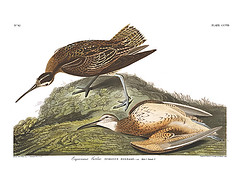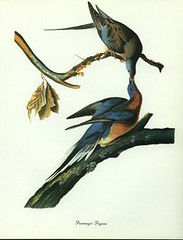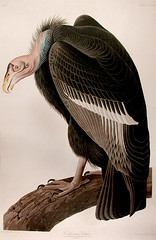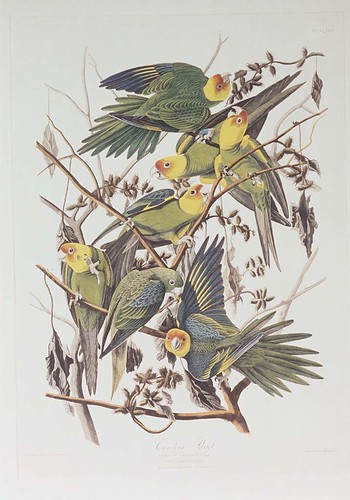tags: John James Audubon, Bird Art, ornithology, birds, avian, New York Historical Society, endangered species
Carolina Parakeet (Carolina Parrot), Conuropsis carolinensis,
by John James Audubon (American, born Santo Domingo [now Haiti], 1785-1851).
Havell plate no. 26.
Watercolor, graphite, pastel, gouache, and black ink with scratching out and selective glazing on paper, laid on thin board.
The Carolina parakeet, Conuropsis carolinensis, now extinct,
was the only native species of parrot in the United States. The last
known wild Carolina parakeet was killed in Florida in 1904 [larger size].
I remember every moment when I saw a new bird species for the first time. I remember how the light caressed its feathers, adding fiery depth to color. I remember each bird's innate busyness as it searched for careless insects or plump fruits, its fierce hope as it courted future mates, the rich sound of its voice as it spoke volumes to its companions. I recall the intense flash of life in its gleaming eyes when it caught sight of me huddled behind my 'scope or binoculars, holding my breath, wishing this singular moment would never end. And I remember that special sound of wings snapping through the air as the bird took flight, leaving me behind, suddenly alone, feet rooted into the moist soil like bricks, while my parched soul rose up alongside.
Endangered and extinct species are especially affecting. And paintings of endangered birds, particularly those rendered while they were still in this world, can trigger intense emotions, as most people will learn when they attend "Audubon's Aviary," the New-York Historical Society's annual springtime exhibition of their extensive collections of the works of artist John James Audubon. [NOTE: click on thumbnail images for larger view of that image in its own window].
Thanks to Audubon, brief glimpses of these extinct birds have been captured and preserved in watercolor for people like me, who never had the privilege of seeing them alive. Every year, the New-York Historical Society presents a different subgroup of its collection of Audubon's avian portraits for public viewing and these paintings are often centered around a particular theme. The Spring 2008 exhibition highlights birds that once flourished throughout a variety of American landscapes and soared through this nation's skies but are currently either declining, threatened with extinction, or gone forever. These evocative paintings, which the artist sold individually by subscription throughout the 1830s and also collected into his seminal tome, Birds of America, served to increase awareness and appreciation for the native birds and wildlife of North America. Unfortunately for some birds, such as North America's only indigenous parrot species, the Carolina parakeet, Conuropsis carolinensis, this appreciation developed far too late.
When you first enter the building, you will find yourself drawn into the exhibition gallery by the birdsongs and calls that ring through the marble halls and stairways. Once inside the exhibition hall, you can borrow one of the large magnifying glasses at the door so you can more easily see each painting's rich detail. To add to the magic of this experience, some bird portraits include recorded calls for that particular species provided by the Cornell Lab of Ornithology. These recordings are activated to play by the viewer's body movements so your approach is heralded by that species' song. Another multi-media supplement in the gallery is a separate, very large, framed "picture" that is actually a large television featuring film clips of fourteen species featured in the displayed portraits. But in this essay, I have chosen to focus on those species that have never been recorded on film or audio, whose bones, skins, feathers and of course, Audubon's paintings, are the only record of and tribute to their existence.
 The extinct great auk, Pinguinus impennis, has the distinction of being the last flightless bird found anywhere in North America. Its scientific name reveals that it was recognized as the original penguin, although it is not related to any currently living penguin species. Unfortunately, Audubon never saw this species alive and curiously, he never finished this painting, leaving one leg as an unpainted ghostly outline on the bird on the left.
The extinct great auk, Pinguinus impennis, has the distinction of being the last flightless bird found anywhere in North America. Its scientific name reveals that it was recognized as the original penguin, although it is not related to any currently living penguin species. Unfortunately, Audubon never saw this species alive and curiously, he never finished this painting, leaving one leg as an unpainted ghostly outline on the bird on the left.
There is evidence from human middens that this species once ranged as far south as parts of Florida, although hunting pressure from humans caused its range to contract solely to certain islands off eastern Canada, Greenland, Iceland, Norway, Ireland and Great Britain. It is known that, although graceful in water, great auks were slow and clumsy on land, and unafraid of humans, which made them easy targets for insatiable human appetites and cruelties. The last pair of great auks, discovered while incubating an egg on a small island near Iceland, were killed on 3 July 1844, for a museum collection.
 Audubon's powerful rendering of the lovely Esquimaux curlew (also known as the Eskimo, or Northern, curlew), Numenius borealis, is sadly prescient, since this is the only picture where one of his main subjects is dead. In this portrait, the dead female lies on her back in the foreground, one wing open, while the male looks at her with what appears to be astonishment.
Audubon's powerful rendering of the lovely Esquimaux curlew (also known as the Eskimo, or Northern, curlew), Numenius borealis, is sadly prescient, since this is the only picture where one of his main subjects is dead. In this portrait, the dead female lies on her back in the foreground, one wing open, while the male looks at her with what appears to be astonishment.
The Esquimaux curlew is currently classified as either critically endangered -- with a population estimated to be no more than 50 individuals -- or more likely, extinct. This elegant shorebird was a champion long-distance migrant that annually flew 20,000 miles or more from southern Argentina, stopping on the North American Great Plains to refuel before moving on to the northwestern tundras of Alaska and Canada to breed. Its population was decimated by an astonishing level of hunting where as many as two million birds were killed in a single year. The pressure from hunting was probably amplified by the extinction of the Rocky Mountain locust, its primary food source during migration. The Esquimaux curlew, once one of the most numerous of all North American shorebirds, is often mistaken for the still extant, but noticeably larger, Whimbrel, or Hudsonian curlew, Numenius phaeopus, which further confuses attempts to determine if this species still exists. The last confirmed sighting of the Esquimaux curlew was in 1963, in the Barbados.
 Because there were between three and five billion living passenger pigeons -- 25 to 40 per cent of the total bird population of the United States -- at the time that Europeans discovered America, the passenger pigeon, also known as the wild pigeon, Ectopistes migratorius, is probably the most famous example of North America's sad saga of extinct birds. Audubon's painting depicts the female leaning down to feed the male, demonstrating the artist's skill at capturing the iridescent feathering on the birds' necks using watercolors.
Because there were between three and five billion living passenger pigeons -- 25 to 40 per cent of the total bird population of the United States -- at the time that Europeans discovered America, the passenger pigeon, also known as the wild pigeon, Ectopistes migratorius, is probably the most famous example of North America's sad saga of extinct birds. Audubon's painting depicts the female leaning down to feed the male, demonstrating the artist's skill at capturing the iridescent feathering on the birds' necks using watercolors.
The passenger pigeon's survival strategy was legendary and is also used by many migratory African mammals; by forming huge groups of hundreds of thousands of individuals, the species was rendered invulnerable to losses inflicted by wild predators. Nevertheless, the formally recognized cause of this species' extinction was rampant killing by humans, although it would probably have succumbed eventually to the ravages of uncontrolled destruction of the East Coast oak forests to establish farms.
But the sad echo of the loss of passenger pigeons still reverberates today because its extinction probably exacerbated the proliferation of Lyme disease. When the passenger pigeons existed in large numbers, they subsisted primarily on acorns. However, since there are no pigeons to eat acorns, the populations of Eastern deer mice -- the main reservoir of Lyme disease -- exploded far beyond historic levels as they exploited this unexpected food bonanza.
 Audubon's knowledge of bird social behavior is demonstrated by a small group of playful and curious Carolina parakeets (also known as the Carolina parrot or conure), Conuropsis carolinensis. In this sweet painting, he captured a small group of these colorful parrots as they romped on their primary foodplant, the invasive cocklebur. The rapid movement of the birds' bodies through the vegetation is apparent from the different lifelike poses, and the birds' inquisitive nature is revealed by those individuals looking directly at the viewer. I was especially enthralled and saddened by their feather texture and coloring -- the birds seem so real and touchable, so near, and yet so far away.
Audubon's knowledge of bird social behavior is demonstrated by a small group of playful and curious Carolina parakeets (also known as the Carolina parrot or conure), Conuropsis carolinensis. In this sweet painting, he captured a small group of these colorful parrots as they romped on their primary foodplant, the invasive cocklebur. The rapid movement of the birds' bodies through the vegetation is apparent from the different lifelike poses, and the birds' inquisitive nature is revealed by those individuals looking directly at the viewer. I was especially enthralled and saddened by their feather texture and coloring -- the birds seem so real and touchable, so near, and yet so far away.
For aficionados of parrots, like me, the senseless loss of the Carolina parakeet is an added insult in the long and sordid history of wanton human disregard for all life forms. The extinction of the Carolina parakeet resulted from loss of its forested habitat to farmers, who also shot the gregarious birds as agricultural pests. This pressure was exacerbated by the desirability of their colorful plumage for decorations on womens' hats and by the pet trade. Unfortunately, parrot owners of the past were not as enlightened as those today, so even though these birds bred easily in captivity, a captive breeding population was never established. Tragically, the final death knell for the tiny remnant population of these parrots was probably a disease found in captive poultry.
 Several North American avian success stories were also included in this exhibition, most notably the California Condor, Gymnogyps californianus. This bird, the largest vulture in North America, was almost lost after its already small population declined dramatically in the 19th century due to the combined effects of poaching, lead shot poisoning, and habitat destruction. Federal laws and eventually, a conservation program that featured captive breeding efforts, were finally enacted to protect this species, whose numbers increased from an all-time low of only nine individuals to a population of 302 birds as of November 2007.
Several North American avian success stories were also included in this exhibition, most notably the California Condor, Gymnogyps californianus. This bird, the largest vulture in North America, was almost lost after its already small population declined dramatically in the 19th century due to the combined effects of poaching, lead shot poisoning, and habitat destruction. Federal laws and eventually, a conservation program that featured captive breeding efforts, were finally enacted to protect this species, whose numbers increased from an all-time low of only nine individuals to a population of 302 birds as of November 2007.

Another conservation success story is that of the beautiful brown pelican, Pelecanus occidentalis, which was nearly lost because of eggshell thinning caused by pesticides like DDT and dieldrin. Close examination with a magnifying glass reveals that Audubon beautifully captured this species in watercolor by using graphite shading on the solid regions of watercolor to provide added texture to this bird's plumage -- a subtle detail you will never see on any reproduction.
The exhibition also featured several of Audubon's sketches and paintings of people in his life, which he produced to improve his observational skills and drawing speed. Additionally, several books that Audubon illustrated with dissected birds, including a woodpecker (dissections of these birds are utterly fascinating), were also included.
The New-York Historical Society is the largest single repository of Auduboniana in the world. Besides cataloguing a variety of Audubon's personal effects, they hold 435 of Audubon's watercolors that were preparatory for 433 of the 435 plates in The Birds of America (1827-1838). (Unfortunately, no original watercolors for plates 84 and 155 are known to exist.) Because of the vulnerability of these paintings to the damaging effects of light, each one of these 435 works are exhibited for only a short period of time once every ten years. Forty paintings were displayed in Spring 2008, along with other drawings and books that are relevant to Audubon's life and work. The exhibition runs from 8 February to 16 March 2008 at the New York Historical Society, 170 Central Park West (SW corner of Central Park West and 77th street), New York, NY 10024.


Beautiful post, if sad. Your first paragraph matches its subject matter in detail and beauty.
Thanks for the great post! I love your description. If I am ever in NYC when the Audubon work is on display I'll have to make sure to see it.
Fabulous article. Wonderful writing.
Thanks,
1hen2ducks
Thanks, a beautiful post, and I hope it didn't take you too long to type. I've taken the liberty of nominating it for THe Open Laboratory 2008.
I went to the New York Historical Society to see the exhibit. It was very interesting. I did not know that this exhibit was there again until I read about it on this blog.
I saw an earlier exhibit at NYHS of Audubon Paintings a few years ago, and when I first saw the news about the Audubon exhibit I thought it was about the exhibit of the Audubon paintings of mammals thats up across the street from the NYHS at the American Museum Of Natural History.
actually, writing this essay took me seven hours, although i should probably not admit that since it detracts from the magic of writing a blog.
this exhibit is simply a must-see for anyone who lives in NYC and particularly for those visiting NYC, partially because it is different every year, and partially because the watercolors are so amazing and rich -- even the finest copies cannot approach the originals for their quality and detail. seeing these paintings in real life really adds to the experience of seeing them in Audubon's Birds of America.
this exhibit is simply a must-see for anyone who lives in NYC and particularly for those visiting NYC, partially because it is different every year, and partially because the watercolors are so amazing and rich
I fully agree. I saw some of the watercolors one year when they were traveling to the Smithsonian at the same time that I was there. I was stunned by one painting in particular; the Black-billed Magpie. Audubon used graphite along with the watercolor to give the feathers an iridescent sheen that is exactly like that of the real bird. I've never seen anything like it; it was a watercolor that had different hues depending upon the viewing angle. My understanding is that no one has been able to duplicate that technique in the intervening decades.
Beautiful! Thanks for contributing this post to this week's Carnival of Family Life hosted at Beauty and Personal Grooming! Be sure to check out the other wonderful entries this week! And if you would like to host a future edition of the Carnival, you can check out the schedule here and then let me know the week you are interested in.
Have a wonderful Sunday -- and Easter (if you are celebrating)!
Beautiful written (seven hours- huh). Wen i come to NYC i will go to see exibit.